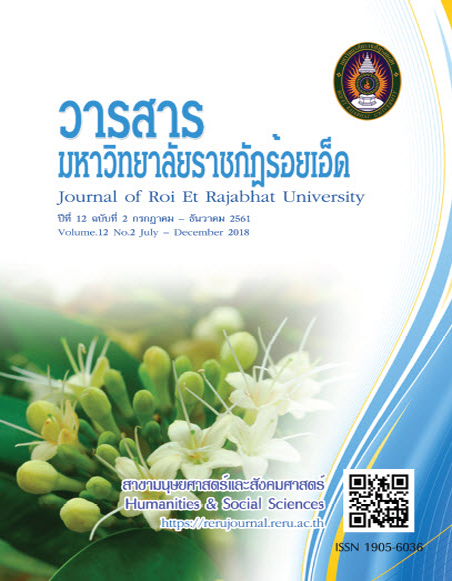People’s Satisfaction from Watching Digital TV after Transition to Digital TV in Roi Et Province
Keywords:
Satisfaction, Digital TV, Analog TVAbstract
The purposes of this research were 1) to study people’s satisfaction from watching digital TV after the transition to digital TV in Roi Et Province, and 2) to compare the people’s satisfaction based on their different factors; genders, ages, education levels, careers, and income. The samples were people from 400 households in Roi-Et Province. The research instrument was a constructed 5 rating scale questionnaire. Data analysis employed descriptive statistics (frequency, mean, and percentage) and inferential statistics (t-test and F-test). The results showed that, after the transition from analogue TV to digital TV, the people’s satisfaction of public relations from government agencies, distribution of set top box coupons, TV content watching, and benefits from watching digital TV was rated at the “high” level, in average. The result of the hypothesis testing showed that different personal factors (genders, ages, careers, and income) did not cause differences in the people’s satisfaction of the transition to digital TV. In contrast, different education levels made differences in the people’s satisfaction of the transition to digital TV at a statistical significant level of 0.05.
References
เชษฐพัฒน์ สิริวัฒนตระการ. (2559). การสร้างความเข้าใจและศึกษาผลกระทบเกี่ยวกับการยุติโทรทัศน์ระบบแอนะล็อกต่อผู้บริโภค จังหวัดร้อยเอ็ด. วารสารมนุษยศาสตร์และสังคมศาสตร์ มหาวิทยาลัยราชพฤกษ์, 2(2), 66–77.
ประกาศคณะกรรมการกิจการกระจายเสียง กิจการโทรทัศน์และกิจการโทรคมนาคมแห่งชาติ. (2555). ราชกิจจานุเบกษา 21ธันวาคม 2555. เล่ม 129 ตอนที่ 192 ง.
วิเชียร เกตุสิงห์. (2538). สถิติวิเคราะห์สาหรับการวิจัย. กรุงเทพฯ: ศูนย์หนังสือจุฬาลงกรณ์มหาวิทยาลัย.
วิมลพรรณ อาภาเวท, สาวิตรีชีวะสาธน์ และชาญ เดชอัศวนง. (2554). พฤติกรรมการสื่อสารใน เฟสบุ๊ค (Facebook) ของนักศึกษามหาวิทยาลัยเทคโนโลยีราชมงคลพระนคร. วารสารวิชาการและวิจัย มทร.พระนคร, 7(2), 119-130.
สำนักวิศวกรรมและเทคโนโลยีกระจายเสียงและโทรทัศน์. (2559). การยุติการออกอากาศแอนะล็อกทีวีของประเทศไทย [ออนไลน์]. สืบค้นเมื่อ 13 พฤศจิกายน 2560, จาก https://www.facebook.com/Broadcast. Engineering. NBTC/photos/
เหมือนตะวัน สุทธิวิริวรรณ. (2559). การเปิดรับ ความรู้ ทัศนคติและพฤติกรรมของผู้ชมรายการต่อดิจิทัลทีวีในเขต กรุงเทพมหานคร. วิทยานิพนธ์ วารสารศาสตรบัณฑิต สาขาวิชาการบริหารสื่อสารมวลชน. กรุงเทพฯ: คณะวารสารศาสตร์และสื่อสารมวลชน มหาวิทยาลัยธรรมศาสตร์.
Katz, Elihu and Lazarsfeld, Paul F. (1955). Personal Influence : The Part Played by People in the Flow of Communication. New York: The Free Press. A Devision of Macmillan Publishing.
Likert, Rensis. (1967). “The Method of Constructing and Attitude Scale”, Reading in Attitude Theory and Measurement. Fishbeic, Matin, Ed. New York: Wiley & Son.
Downloads
Published
How to Cite
Issue
Section
License
บทความที่ได้รับการตีพิมพ์เป็นลิขสิทธิ์ของวารสารมหาวิทยาลัยราชภัฎร้อยเอ็ด
ข้อความที่ปรากฏในบทความแต่ละเรื่องในวารสารวิชาการเล่มนี้เป็นความคิดเห็นส่วนตัวของผู้เขียนแต่ละท่านไม่เกี่ยวข้องกับมหาวิทยาลัยราชภัฎร้อยเอ็ด และคณาจารย์ท่านอื่นๆในมหาวิทยาลัยฯ แต่อย่างใด ความรับผิดชอบองค์ประกอบทั้งหมดของบทความแต่ละเรื่องเป็นของผู้เขียนแต่ละท่าน หากมีความผิดพลาดใดๆ ผู้เขียนแต่ละท่านจะรับผิดชอบบทความของตนเองแต่ผู้เดียว





